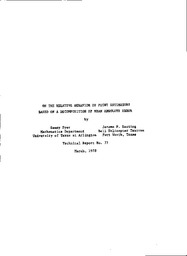
ATTENTION: The works hosted here are being migrated to a new repository that will consolidate resources, improve discoverability, and better show UTA's research impact on the global community. We will update authors as the migration progresses. Please see MavMatrix for more information.
Show simple item record
| dc.contributor.author | Dyer, Danny D. | en |
| dc.date.accessioned | 2010-06-04T13:44:01Z | en |
| dc.date.available | 2010-06-04T13:44:01Z | en |
| dc.date.issued | 1978-03 | en |
| dc.identifier.uri | http://hdl.handle.net/10106/2363 | en |
| dc.description.abstract | **Please note that the full text is embargoed** ABSTRACT: Let [see pdf for notation] be a family of probability density functions indexed by the parameter [see pdf for notation]. We assume at least one of the
[see pdf for notation] is unknown. Based on a random sample of size n from [see pdf for notation],
let [see pdf for notation] be two point estimators of the real-valued function [see pdf for notation], where [see pdf for notation] are specified constants, if any. When comparing [see pdf for notation] and [see pdf for notation], it is quite common to examine the ratio of their respective average precisions usually measured by either mean squared error, [see pdf for notation], or mean absolute error, [see pdf for notation], where [see pdf for notation]. If, for example, [see pdf for notation] for
some w0' then 02 is said to be more mean squared efficient than [see pdf for notation] at [see pdf for notation]. However, the numerical value of such a ratio provides very limited insight into the actual relative behavior of the two competing estimators.
We, therefore, propose a twofold technique for comparing [see pdf for notation] and which essentially determines (a) the "odds" in favor of [see pdf for notation]
being closer to [see pdf for notation] than is [see pdf for notation] and (b) the average closeness of
[see pdf for notation] to [see pdf for notation] not only when [see pdf for notation] is closer to [see pdf for notation] than is [see pdf for notation] but also when it is not. Closeness to [see pdf for notation] is measured through an absolute error loss function: [see pdf for notation]. Furthermore, joint consideration of these two concepts is shown to provide a basis for determining which of the two estimators, [see pdf for notation] or [see pdf for notation], is preferred in a given situation. An application of these results will be made with regard to the comparison of estimators of certain reliability characteristics in the exponential failure model. | en |
| dc.language.iso | en_US | en |
| dc.publisher | University of Texas at Arlington | en |
| dc.relation.ispartofseries | Technical Report;77 | en |
| dc.subject | Exponential failure model | en |
| dc.subject | Absolute error loss function | en |
| dc.subject | Estimators | en |
| dc.subject.lcsh | Decomposition (Mathematics) | en |
| dc.subject.lcsh | Statistics | en |
| dc.subject.lcsh | Mathematics Research | en |
| dc.title | On the Relative Behavior of Point Estimators Based on a Decomposition of Mean Absolute Error | en |
| dc.type | Technical Report | en |
| dc.publisher.department | Department of Mathematics | en |
Files in this item
- Name:
- MathTechReport077.pdf
- Size:
- 630.4Kb
- Format:
- PDF
- Description:
- PDF
This item appears in the following Collection(s)
Show simple item record


